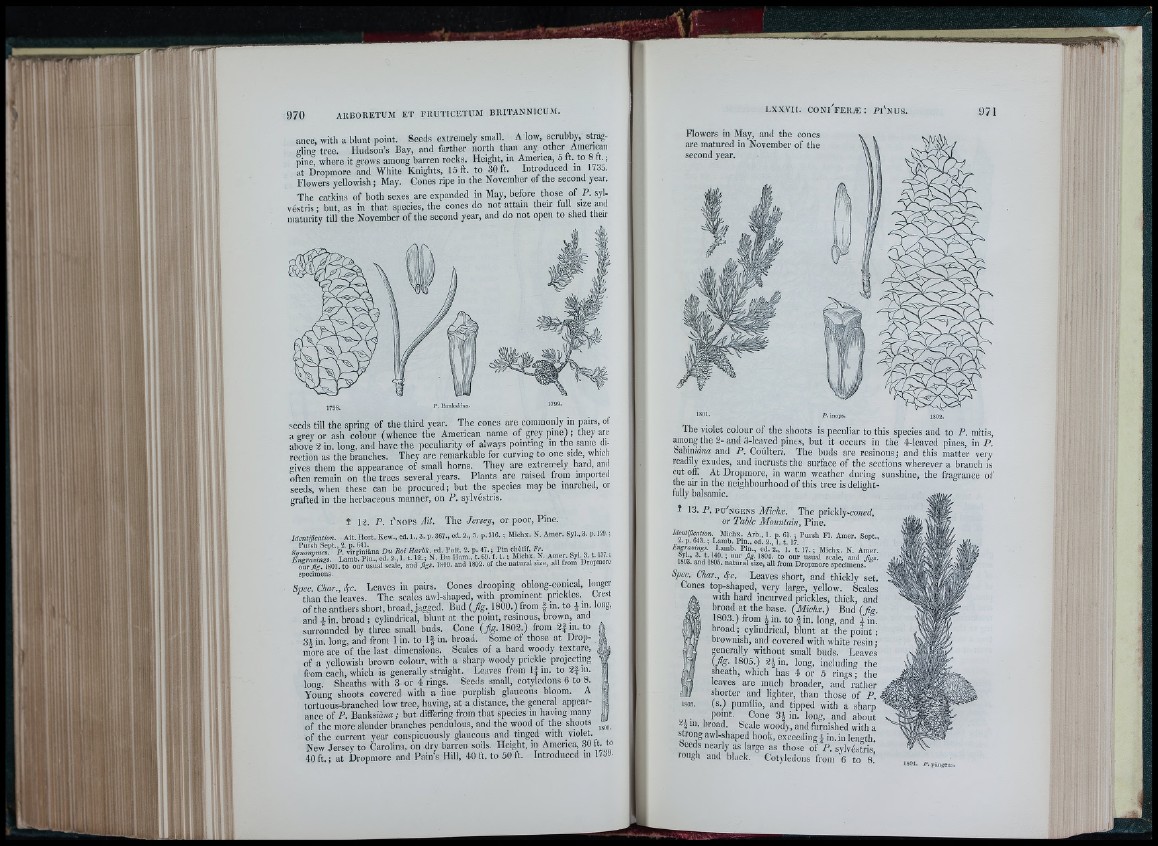
9 7 0 A U B O R E T U M E T F R U T IC E T U M B R IT A N N IC U M .
ance, with a blunt point. Seeds extremely small. A low, scrubby, straggling
tree. Hudson’s Bay, and farther north than any other Amencan
pine, where it grows among barren rocks. Height, in America, S ft. to 8 ft. ;
[,t Dropmore and White Knights, 15ft. to 30 ft. Introduced in 1735.
Flowers yellowish; May. Cones ripe in the November of the second year.
The catkins of both sexes are expanded in May, before those of P. sylvéstris
; but, as in that species, the cones do not attain their full size and
maturity till the November of the second year, and do not open to shed their
jy g g P. Banksirina. 1>J9-
seeds till the spring of the third year. The cones are commonly in pairs, of
a grey or ash colour (whence the American name of grey pine) ; they are
above 2 in. long, and have the peculiarity of always pointing in the same direction
as the branches. They are remarkable for curving to one side, which
"ives them the appearance of small horns. They are extremely hard, and
often remain on the trees several vears. Plants are raised from imported
seeds, when these can be procured ; but the species may be inarched, or
grafted in the herbaceous manner, on P. sjlvestris.
i 12. P. i 'n o p s «lit. The Jersey, or poor. Pine.
uenti/tcation. Ait. Hort. Kew., ed. 1., 3. p. 367., ed. 2., 5. p. 316. ; Michx. N. Amer. Syl.,3. p. 129. ;
h'-naffiinan T amh Pin ed.2.. 1. 1 .12.: N. Dn Ham., t. 69. f. 1. ; Michx. N. Amer. SSvyil . 33. 1t .113577 .,■
¡0 oùr usùal scale, and Jigs. 1800. and 1802. of the natural size, all from Dropmore
specimens.
spec. Char., Sfc. Leaves in pairs. Cones drooping oblong-conical, longer
than the leaves. The scales awl-shaped, with prominent prickles. Crest
of the anthers short, broad, jagged. Bud (fig . 1800.) from | m. to J in long,
and iin . broad ; cylindrical, blunt at the point, resinous, brown, and
surrounded by three small buds. Cone {fig. 1802.) from 2 | in. to
3 1 in. long, and from 1 in. to I f in. broad. Some of those at Drop-
more are of the last dimensions. Scales of a hard woody texture,
of a yellowish brown colour, with a sharp woody prickle projecting
from each, which is generally straight. Leaves from I f in. to 2 | m.
long. Sheaths with 3 or 4 rings. Seeds small, cotyledons 6 to 8 .
Young shoots covered with a fine purplish glaucous bloom. A
tortuous-branched low tree, having, at a distance, the general appearance
of P. Bankszana ; but differing from that species in having many
of the more slender branches pendulous, and the wood of the shoots
o fth e current year conspicuously glaucous and tinged with violet.
New Jersey to Carolina, on drv barren soils. Height, m Amenca, 30 tt. to
40 ft.; at Dropmore and Pain’s Hill, 40 ft. to 50ft. Introduced in 1739.
L X X V I I . c o n i ' f e UìE : p i ' n u s . 97 1
Flowers in May, and the cones
are matured in November of the
second year.
The violet colour of the shoots is peculiar to this species and to P. mitis,
among the 2 -and 3-leaved pints, but it occurs in the 4-leaved pines, in P.
Sabimdtta and P. Coulteri. The buds are resinous; and this matter very
readily exudes, and incrusts the surface of the sections wherever a branch i.s
cutoff^ At Dropmore, in warm weather during sunshine, the fragrance of
the air in the neighbourhood of this tree is delightfully
balsamic.
i 13. P. p u V g e n s Michx. The fficVày-coned,
or Table Mountain, Pine.
IdmtiJwaUon. Michx. Arb., 1. p. 61. ; P ursh F l. Amer. Sept.,
2. p. 643. ; Lamb. Pm., ed. 2., 1. t. 17
FngrawWs Lamb. Pin., ed .2 ., 1. t. 17. ; Michx. N. Amer.
ism’ o u r/g -. 1804. to our usual scale, and figs.
1803. and 1805. natural size, all from Dropmore specimens.
Sjiec. Char., ^c . Leaves short, and thickly set.
Cones top-shaped, very large, yellow. Scales
with hard incurved prickles, thick, and
broad at the base. {Michx.) Bud {fig.
1803.) from | in. to fin . long, and f in.
broad; cylindrical, blunt at the point ;
brownish, and covered with white resin ;
generally without small buds. Leaves
{fig. 1805.) 2L in. long, including the
sheath, which has 4 or 5 rings; the
leaves are much broader, and° rather
shorter and lighter, than those of P.
1803. (s.) pumilio, and tipped with a sharp
• I iong, and about
■¿2 “L broad. Scale woody, and furnished with a
strong awl-shaped hook, exceeding 4 in. in length
beeds nearly as large as those of P. sylvéstris,
rough and black. Cot.yledons from 6 to 8 . .g«,.